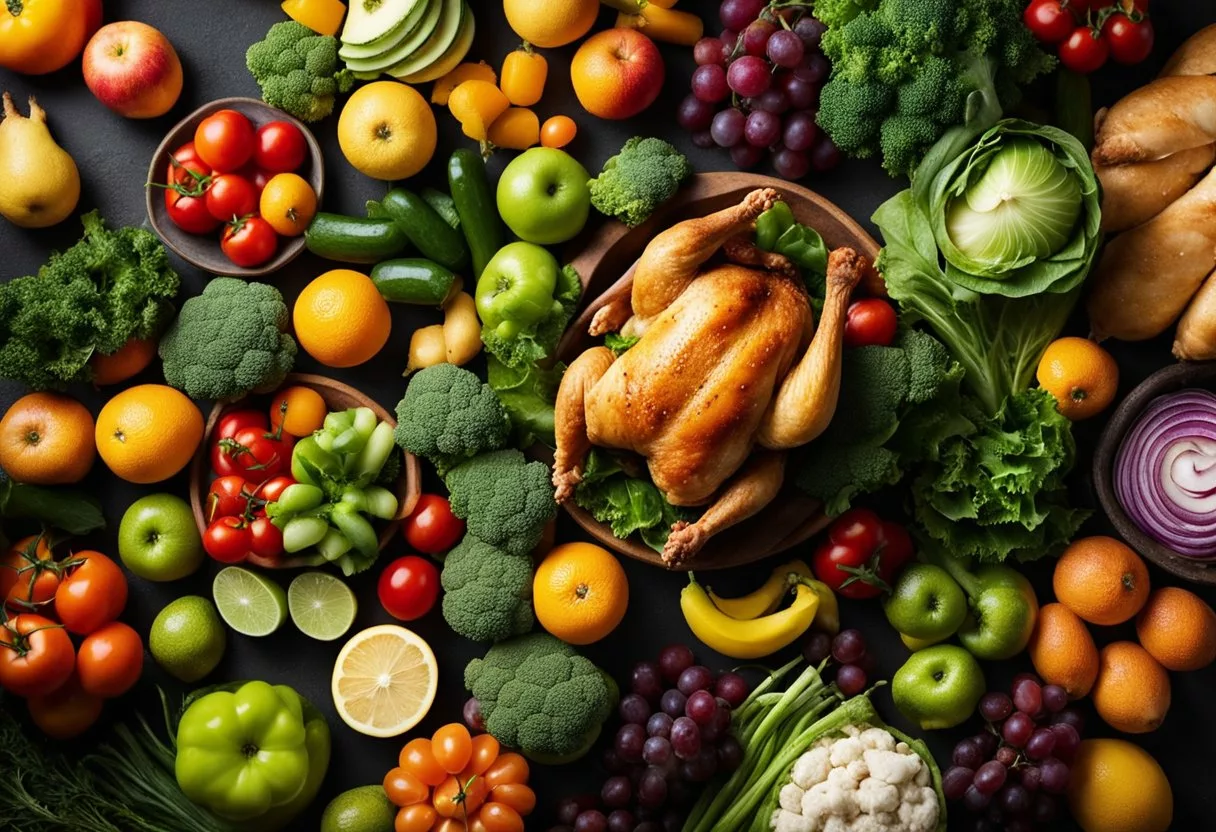Eating chicken every day is a common habit for many people around the world. Chicken is a lean protein source that is low in fat and high in essential nutrients such as vitamins and minerals. However, like any other food, consuming chicken every day can have both positive and negative effects on the body.

On the positive side, chicken is a great source of protein, which is essential for building and repairing muscles, as well as maintaining healthy skin, hair, and nails. It also contains important vitamins and minerals such as vitamin B6, niacin, phosphorus, and selenium. These nutrients are important for maintaining healthy bones, boosting the immune system, and improving brain function.
However, eating chicken every day can also have negative effects on the body. For example, consuming chicken that is breaded or fried can increase the risk of heart disease due to the high amount of saturated and trans fats. Additionally, eating chicken that has been raised with antibiotics can lead to the development of antibiotic-resistant bacteria in the body. It is important to be aware of the potential risks associated with consuming chicken every day and to make informed decisions about what type of chicken to eat and how often to consume it.
Nutritional Value of Chicken

Chicken is a popular source of protein and is consumed worldwide. It is a nutrient-rich food that provides several essential vitamins and minerals to the body. The following subsections highlight some of the key nutritional aspects of chicken.
Protein Content and Muscle Growth
Chicken is an excellent source of high-quality protein, which is essential for building and repairing muscles. According to Healthline, a 100-gram serving of chicken breast contains about 31 grams of protein, making it an ideal food for people who want to build muscle mass.
Vitamins and Minerals in Chicken
Chicken is a good source of several essential vitamins and minerals. It contains vitamin B12, which is important for the proper functioning of the nervous system and the production of red blood cells. It also contains vitamin B6, which is essential for brain development and the synthesis of neurotransmitters. Additionally, chicken is rich in minerals such as iron, selenium, and zinc, which are important for maintaining good health.
Calories and Fat
Chicken is a low-fat and low-calorie food, making it an ideal choice for people who want to maintain a healthy weight. A 100-gram serving of chicken breast contains only about 165 calories and 3.6 grams of fat, of which only 1 gram is saturated fat. However, some parts of the chicken, such as the skin, contain higher amounts of fat and calories. Therefore, it is important to choose lean cuts of chicken and remove the skin before cooking to reduce the overall calorie and fat intake.
In summary, chicken is a nutrient-rich food that provides high-quality protein, essential vitamins, and minerals to the body. It is a healthy food choice for people who want to build muscle mass, maintain a healthy weight, and improve their overall health.
Health Benefits of Eating Chicken

Chicken is a popular food that is consumed worldwide due to its taste, versatility, and nutritional value. It is a great source of lean protein, which is essential for building and repairing tissues in the body. In this section, we will discuss some of the health benefits of eating chicken.
Heart Health and Cholesterol
Chicken is a low-fat protein source that can help maintain a healthy heart. According to EatingWell, chicken breast without skin is a lean protein that contains less saturated fat than other animal protein sources. This can help reduce the risk of heart disease and lower cholesterol levels in the body.
Weight Management and Satiety
Chicken is also a good food for those trying to lose weight or maintain a healthy weight. The high protein content in chicken can help increase satiety and reduce hunger cravings, making it easier to stick to a healthy eating plan. In addition, chicken is a low-calorie food that can be incorporated into many different recipes, making it a versatile ingredient for weight loss diets.
Bone Health and Strength
Chicken is a good source of several nutrients that are essential for bone health and strength. According to WebMD, chicken is rich in phosphorus, which is necessary for strong bones, as well as calcium and magnesium, which are important for maintaining bone density.
Immune System Support
Chicken contains several nutrients that can help support a healthy immune system. It is rich in zinc, which is essential for the production of immune cells and the maintenance of a healthy immune response. Chicken also contains vitamin B6, which is important for the production of antibodies that help fight off infections and diseases.
In summary, chicken is a nutritious food that provides several health benefits. It is a great source of lean protein, which is essential for building and repairing tissues in the body. Chicken can also help maintain a healthy heart, support weight loss, promote bone health, and support a healthy immune system.
Risks and Considerations

Cancer Risks and Dietary Guidelines
According to the American Cancer Society, eating a diet high in red and processed meats, including chicken, has been linked to an increased risk of colorectal cancer [1]. The World Health Organization has classified processed meats as a Group 1 carcinogen, meaning they are known to cause cancer in humans [2]. Therefore, it is important to limit the consumption of chicken and other meats in order to reduce the risk of cancer.
The Dietary Guidelines for Americans recommend consuming a variety of protein sources, including lean meats, poultry, and plant-based proteins [3]. It is recommended to choose lean cuts of meat and to limit the consumption of processed meats, such as chicken nuggets and hot dogs.
Sodium and Blood Pressure
Chicken can be high in sodium, which can contribute to high blood pressure and an increased risk of heart disease [4]. It is important to choose low-sodium options when consuming chicken, such as grilled or baked chicken without added salt.
The American Heart Association recommends consuming no more than 2,300 milligrams of sodium per day, and ideally less than 1,500 milligrams per day for most adults [5]. One serving of chicken can contain up to 1000 milligrams of sodium, so it is important to be mindful of portion sizes and the amount of sodium in each serving.
Hormones and Antibiotics in Chicken
Some chickens may contain hormones and antibiotics, which can have negative health effects [6]. Hormones are sometimes given to chickens to promote growth, but this can lead to an increased risk of breast cancer and other health issues [7]. Antibiotics are often given to chickens to prevent disease, but this can contribute to antibiotic resistance in humans.
It is important to choose chicken that is free from added hormones and antibiotics. Look for labels such as “no antibiotics ever” or “raised without antibiotics” when purchasing chicken.
In summary, while chicken can be a healthy source of protein, it is important to be mindful of the risks and considerations associated with consuming it. By choosing lean cuts of meat, limiting processed meats, choosing low-sodium options, and selecting chicken that is free from added hormones and antibiotics, individuals can reduce their risk of negative health effects.
[1] American Cancer Society. (2021). Red and processed meats and cancer risk. https://www.cancer.org/latest-news/world-health-organization-says-processed-meat-causes-cancer.html
[2] World Health Organization. (2015). Q&A on the carcinogenicity of the consumption of red meat and processed meat. https://www.who.int/features/qa/cancer-red-meat/en/
[3] U.S. Department of Health and Human Services and U.S. Department of Agriculture. (2020). Dietary Guidelines for Americans, 2020-2025. https://www.dietaryguidelines.gov/sites/default/files/2020-12/Dietary_Guidelines_for_Americans_2020-2025.pdf
[4] Centers for Disease Control and Prevention. (2021). Sodium and Food Sources. https://www.cdc.gov/salt/sources.htm
[5] American Heart Association. (2021). How much sodium should I eat per day? https://www.heart.org/en/healthy-living/healthy-eating/eat-smart/sodium/how-much-sodium-should-i-eat-per-day
[6] Consumer Reports. (2014). How Safe is Your Chicken? https://www.consumerreports.org/cro/magazine/2014/02/how-safe-is-your-ground-beef/index.htm
[7] National Cancer Institute. (2019). Hormones in Meat. https://www.cancer.gov/about-cancer/causes-prevention/risk/diet/hormones-in-meat-fact-sheet
Comparing Chicken with Other Protein Sources
Chicken vs. Red Meat and Processed Meats
Chicken is a popular choice for those looking to add more protein to their diet. Compared to red meat and processed meats, chicken is generally considered to be a healthier option due to its lower levels of saturated fat and calories. For example, a 3-ounce serving of chicken breast contains about 140 calories and 3 grams of fat, while a similar serving of beef contains about 180 calories and 8 grams of fat.
Processed meats, such as bacon and sausage, are also high in calories and saturated fat. Consuming these meats on a regular basis has been linked to an increased risk of heart disease and other health problems. Therefore, chicken is a better choice for those looking to maintain a healthy diet.
Plant-Based Protein Alternatives
For those who prefer to avoid animal products altogether, there are many plant-based protein alternatives to consider. Beans, nuts, legumes, seeds, and lentils are all great sources of protein and can be used in a variety of dishes.
Tofu is another popular option, especially for those following a vegetarian or vegan diet. It is made from soybeans and contains all nine essential amino acids, making it a complete protein source. Tofu can be used in a variety of dishes and is a great way to add protein to a meal.
Seafood as an Alternative Protein
Seafood is another great alternative to chicken and other meats. Salmon, for example, is a great source of omega-3 fatty acids, which are important for heart health. A 3-ounce serving of salmon contains about 120 calories and 5 grams of fat, making it a lean protein option.
Other types of seafood, such as shrimp and crab, are also low in calories and high in protein. They can be used in a variety of dishes and are a great way to add more protein to your diet.
In summary, while chicken is a great source of protein, there are many other options to consider. Plant-based protein alternatives, such as beans, nuts, and lentils, are great for those who prefer to avoid animal products. Seafood is another great alternative, especially for those looking for a lean protein source. By incorporating a variety of protein sources into your diet, you can ensure that you are getting all the nutrients you need to maintain a healthy lifestyle.
Cooking Methods and Their Impact

Grilling and Baking
Grilling and baking are two popular cooking methods for chicken. Grilling chicken is a healthier option than frying because it allows the fat to drip off the meat. Baking chicken is also a healthy option because it requires no added fat. However, when grilling or baking chicken, it is important to remove the skin to reduce the amount of saturated fat consumed.
Frying and Health Implications
Frying chicken is a tasty option, but it is not the healthiest cooking method. When chicken is fried, it absorbs a lot of oil, which increases the calorie content of the meat. Additionally, fried chicken is often breaded, which adds more calories and carbohydrates to the dish. If you must fry chicken, it is best to use skinless chicken breast and to fry it in a healthy oil like olive oil.
Poaching and Low-Fat Cooking
Poaching is a low-fat cooking method that involves cooking chicken in liquid, such as water or broth, at a low temperature. This method is great for those who want to reduce their fat intake. Poached chicken can be used in salads, sandwiches, and other dishes. It is important to note that poached chicken may lack flavor, so it is important to add spices and seasonings to enhance the taste.
In conclusion, the cooking method used when preparing chicken can impact its nutritional value. Grilling and baking are healthier options, while frying should be avoided or done in moderation. Poaching is a low-fat cooking method that can be a great option for those looking to reduce their fat intake. Regardless of the cooking method used, it is important to remove the skin to reduce the amount of saturated fat consumed.
Incorporating Chicken into a Balanced Diet

When it comes to incorporating chicken into a balanced diet, it’s important to keep in mind that variety is key. While chicken is a great source of lean protein, it shouldn’t be the only source of protein in your diet.
Diversity in Protein Intake
To ensure a diverse protein intake, consider incorporating other lean protein sources such as fish, tofu, and legumes. This will not only provide your body with a wider range of essential amino acids, but it will also add variety to your meals.
Vegetables, Fruits, and Whole Grains
In addition to protein, it’s important to incorporate a variety of vegetables, fruits, and whole grains into your diet. These foods provide essential vitamins, minerals, and fiber that are important for overall health.
Portion Sizes and Frequency
When it comes to incorporating chicken into your diet, it’s important to pay attention to portion sizes and frequency. A serving of chicken is typically 3-4 ounces, or about the size of a deck of cards. It’s also important to vary the preparation methods, such as grilling, baking, or sautéing, to avoid getting bored with the same flavor.
Overall, incorporating chicken into a balanced diet can be a great way to add lean protein to your meals. Just remember to vary your protein sources, incorporate a variety of vegetables, fruits, and whole grains, and pay attention to portion sizes and frequency.